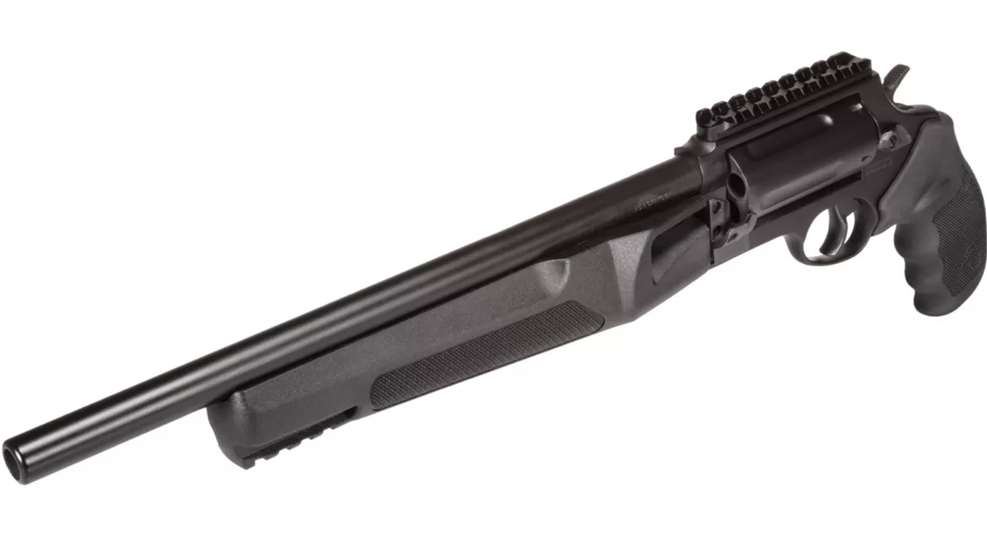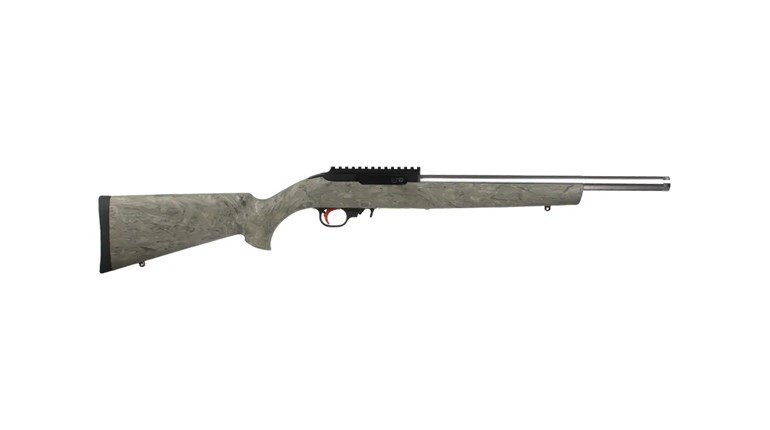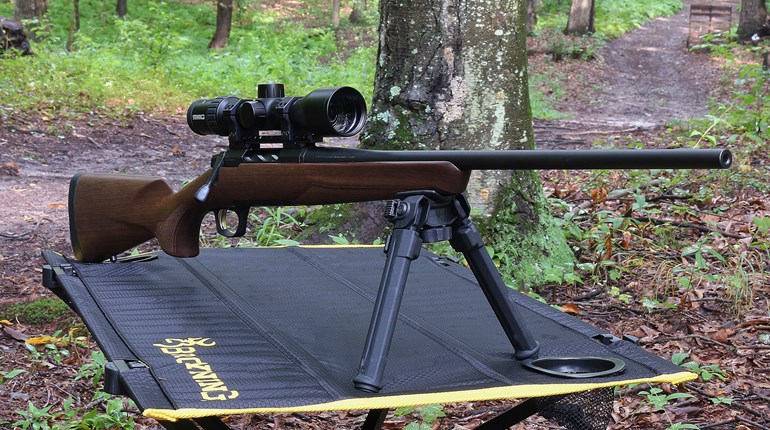
In 2006, Taurus shook up the handgun market with the release of The Judge five-shot double-action revolver. What made it stand out from the crowd then, and still does today, is its dual-caliber configuration which allows it to safely chamber and fire both .45 Colt revolver cartridges and .410-bore shotgun shells. Although it was not the first .45 Colt/.410 handgun to reach the marketplace, it offered a just-right balance of size, features and retail pricing to make it a hit with the shooting sports community. It’s been a staple product for Taurus ever since.

Taurus has offered several models of the judge with various barrel lengths and finishes over the years. Some have longer cylinders and frames made to accommodate both 2.5" and 3" .410-bore shells while most are sized for just the 2.5" shells to make the gun more compact. Eventually Taurus teamed up with Rossi to offer the Circuit Judge revolving carbine outfitted with an 18" barrel, rifle sights, an optics rail and a shoulder stock.

For 2023, Taurus decided it was time to launch a new long-barrel Judge unlike any that came before. Dubbed the Home Defender, it’s most likely intended to compete with non-NFA firearms like the .410-bore Mossberg Shockwave and the Henry Repeating Arms Axe.

The Home Defender’s Features
In essence, the Judge Home Defender is a cross between the 3" cylinder polymer-stocked Rossi Circuit Judge carbine and a Judge revolver. Depending on how you look at it, the round profile barrel has been shortened, or lengthened, to 13" for an overall length of 19.5". This makes the gun fairly lengthy by handgun standards but quite compact when compared to shoulder stocked .410 Bore shotguns and the non-NFA firearms of the same caliber.

The polymer carbine-style fore-end features a molded-in accessory rail for weapon-mounted lights.
Whether a .410 is a combat shotgun or a non-NFA firearm, it must have an overall length of 26" or more to be sold in the United States without the ATF tax stamps and paperwork required to own a short-barrel shotgun (SBS). This version of the Judge is still legally considered a handgun, albeit a long one, that does not fall under the purview of NFA regulations. And for those who are curious to know, this gun has the same slow 1:30" rifling twist rate as the carbine instead of the faster 1:12" twist of the 6" barrel, or shorter, Judge revolvers.
The rifle sights of the Circuit Judge are omitted in favor of a factory installed 3.75" Picatinny rail intended to support compact and easy to use micro red dot optics. In this case, the revolver was fitted with a top-notch Swamp Fox closed emitter Kraken optic with a 3 MOA red dot (KRK00116-3R). This optic probably looks tall and boxy on this gun, like a rifle optic, but that's a good thing. The square shape frames the dot nicely and sits up high enough to allow the revolver to point down range naturally and intuitively.

Gas-deflector shields are mounted to the right and left of the cylinder gap.
The checkered polymer fore-end is a straight lift from the carbine. A very handy feature at the muzzle end of this stock is a molded-in 2" long 4-slot Picatinny accessory rail which will support a variety of weapon-mounted lights. None of the .410-bore shotguns I've worked with ship from the factory flash-light ready like this one.

Like most Judge revolvers, this version has a five-round capacity.
Another important feature borrowed from the carbine is a pair of vented gas-deflector shields mounted to the revolver's frame in between the polymer fore-end and the front of the cylinder. These shields deflect the hot gases that escape sideways from the gap between the cylinder and the barrel. This protects the support hand from getting burned. I shot this revolver extensively with bare hands and short sleeves with my support hand in the forward position. I felt the breeze but not the heat, so the shields work effectively.

The rubber revolver style grip works to reduce felt recoil.
The rest of this gun is straight out of the Taurus Judge steel-framed revolver's playbook. The fluted 3" cylinder holds up to five rounds of .45 Colt, 2.5" .410-bore shells or 3" shells. The cylinder rotates counter clock and swings out to the left when the wedge-shaped cylinder release, on the left side of the frame, is pressed forward towards the muzzle. The exposed hammer has a transfer-bar safety and a checkered spur for improved purchase, and allows the revolver to be cocked for single-action fire. The revolver ships with a compact, textured and finger grooved soft rubber grip. This grip completely covers the grip frame with a thick pad along the backstrap which works to help mitigate felt recoil.

The Swampfox enclosed emitter Kraken red-dot optic is an ideal fit for use with this model’s optics rail.
There was a time years ago when Taurus revolver triggers could be exceptionally heavy, rough or both. But those times have passed. I found the trigger on this particular Judge to be smooth and enjoyable to work with right out of the box. The double-action (un-cocked) trigger's arch of travel was 7/8" with a pull weight of 9 lbs. 12 oz. That may sound heavy but double-action triggers on some revolvers are 12 lbs. or more. Cocking the hammer for single-action fire shortened the trigger's travel to 1/8" and reduced the trigger pull to 4 lbs. 12 oz.

The Mossberg non-NFA Shockwave (top) and the Home Defender (bottom) can both hold up to five rounds of 3” long .410-bore shotgun shells.
.45 Colt/.410 Bore Revolver Performance
I've made the effort to test every .45 Colt/.410-bore handgun, shotgun and non-NFA firearm that I could lay hands on. Although I certainly haven't tested them all, I've handled the majority of them. I can honestly say there is not anything else quite like the Judge Home Defender currently on the market. That being said, I do believe it’s possible to make some useful comparisons based on past experience.

This version of the Judge can fire .45 Colt revolver rounds (left) along with 2.5” (center) and 3” (right) .410-bore shotgun shells
Is a .410 bore effective for home defense? We've answered that question in this write-up which says yes, it can be a useful low-recoil option when loaded properly. However, that information is based on results generated with 18.5" and 14" smooth-bore .410-cal. shotgun barrels. This Judge sports a 13" rifled barrel sized for .452-cal. .45 Colt bullets. This is important to know because a .45 Colt/.410 bore revolver barrel can alter shot shell patterns significantly.

Shotshell patterning for the Home defender was conducted at 7 yards.
A given shell which produces useful shot patterns out to 25 yards or more from a smooth 18.5" barrel may only be able to do so at around 5 to 10 yards when fired from a Judge. Therefore the shot patterning for this gun was conducted at 7 yards which is commonly considered a minimum defensive handgun distance. Single-shot patterns were captured using Birchwood Casey Shoot-N-C 12" x18" silhouette targets.

The author found the gas-deflector shields to be effective in protecting the support hand from the heat escaping from the cylinder gap.
The .410-bore birdshot shells are not a good fit for home defense. While some may argue that 12-gauge and 20-gauge birdshot rounds can get the job done at close range, .410 shells simply do not launch enough lead to be counted on in a defensive situation. However, they are great for pest control and I can see this gun being a handy option in that role.
Winchester's 2.5" long AA #9 lead birdshot cartridge, filled with half an ounce, or about 292 pellets, of quite small lead shot, covered the target evenly from top to bottom with a relatively dense pattern.

I rustled up an old box of Federal Premium 3" Hi Brass Game Shok (H4136) which launches 11/16-oz., or about 155 pellets, of #6 lead birdshot. Although the pattern covered the target, the pellets spread much more quickly at this distance than the #9 shot. So of the two, the Winchester shell with the finer shot would be the better option for pests using this gun.

When it comes to home defense at up-close and personal distances, buckshot loads are a top choice for all shotgun gauges. It should be noted here that I’ve found some imported rounds can cause .45 Colt/.410 revolvers to jam up or they can be quite difficult to eject from the cylinder. When using buckshot loads in a Taurus Judge, it's best to stick with the American-made 2.5" .410 shells, filled with three or four pieces of buckshot, and 3" shells that hold five pieces of shot. Because this Judge will accept 3” shells, I used Winchester's 3" Super X load that fires five pieces of unplated lead 000 buckshot. The five balls, which flattened out a bit, formed a 4.52" pattern with the wad following one of the pieces of shot through the target.

The Taurus Judge has been popular enough that ammunition makers have developed .410 shells specifically for this platform. A common feature of these specialized rounds is mixed payloads, meaning, different types of projectiles fired at the same time. Hornady offers the 2.5" long Critical Defense Triple Threat load which contains a single .41-cal. 115-gr. FTX lead slug at the front with two .35-cal. lead balls weighing in at 65 grains each tucked in behind it. In this case, the three projectiles and the wad flew close together to form a 1.49" pattern with just two impacts to the target.

Although .410 slugs are a good fit for hunting with smooth-bore shotguns, they should be avoided when using a Judge revolver for two reasons. First, a .410-cal. rifled slug rattling down a larger .452-cal. rifled barrel produces poor accuracy results. Secondly, these hollowed out, lightweight lead slugs tend to dump their energy quickly resulting in low penetration. They can also shatter on impact resulting in performance similar to birdshot loads.

Bench-rested accuracy testing with .45 Colt produced tighter groups than expected.
If you want or need to fire a single projectile from the Judge Home Defender, a .45 Colt revolver cartridge is the best option. Modern jacketed bullets are preferable to un-jacketed soft lead bullets. But based on previous 6" barrel revolver tests, I did not expect very tight groups with .45 Colt since practical accuracy (3” to 3.5” groups) tends to be reached at 15 yards instead of 25 yards or more with revolvers that shoot .45 Colt only. This is because the Judge’s 3" chambers about 1.70" longer than the .45 Colt needs them to be. This gives the .452-cal. bullets a relatively long distance to travel before engaging the barrel's rifling.

Two of the sub-one-inch groups fired at 7 yards.
For the .45 Colt, bench-rested accuracy testing was conducted using Champion VisiShot 18"x 13" sight-in targets. Winchester's Super X Silver Tip 225-gr. jacketed hollow point produced a muzzle velocity of 916-fps. for 419 ft.-lbs. of energy according to the MagnetoSpeed V.3 chronograph. Although I didn't expect the longer 13" barrel to make much of a difference in the .45 Colt accuracy, it did!

The tightest 1.06” group fired at 15 yards.
At 7 yards this gun and optic combination produced all-shots touching, ragged hole 5-shot groups of 0.68" and 0.85". Moving the target out to what I thought would be the maximum useful distance of 15 yards yielded groups just over an inch in size, the best being 1.06". Based on these results, it looks like the Home Defender is the first Judge revolver that has the potential to be an accurate hitter out to 25 yards and beyond.
Does This Judge Bring Home the Bacon?
The new Taurus Judge Home Defender revolver is among the more unique offerings in the already unusual .45 Colt/.410 firearm class. With a suggested retail price of $729.99, its 13" barrel length, 5-round ammunition capacity and vertical revolver grip make it more comparable to the non-NFA firearms, like the pump-action .410-bore Mossberg 590 Shockwave and the Henry Axe lever-action, than a handgun. But it brings some notable advantages to the table.
Unloaded, the Home Defender tips the scales at 58 oz. (3 lbs. 10 ozs.) making it significantly lighter than the Shockwave (4 lbs. 4 oz.) and the Axe (5 lbs. 14.6 oz.). However, it weighs between 26 oz. to 29 oz. heavier than typical Taurus Judge revolvers. The added forward weight and being able to grasp the textured polymer forend with the support hand tames the felt recoil noticeably, making this version of the Judge easier to control and more comfortable to shoot.
The revolver arrives weapon's-light and optics ready right out of the box. The rubber revolver grip feels familiar, points more naturally and keeps the shooting hand wrist straighter than the Shockwave style grips. A micro red dot optic provides a useful, intuitive sight picture in most lighting conditions.
Verifying if a gun is loaded is quicker and easier with a swing-out cylinder than a tubular magazine. This gun can fire .45 Colt, and do so accurately, in addition to 2.5" and 3" .410-bore shotgun shells. But the standout feature when compared to the non-NFAs is that there is no need to practice working a pump or swinging a lever between shots. Just pull the trigger to fire the next round.
Is the long-barrel Home Defender the right gun for your needs? You'll have to be the judge of that. For more information, visit taurususa.com.
















































